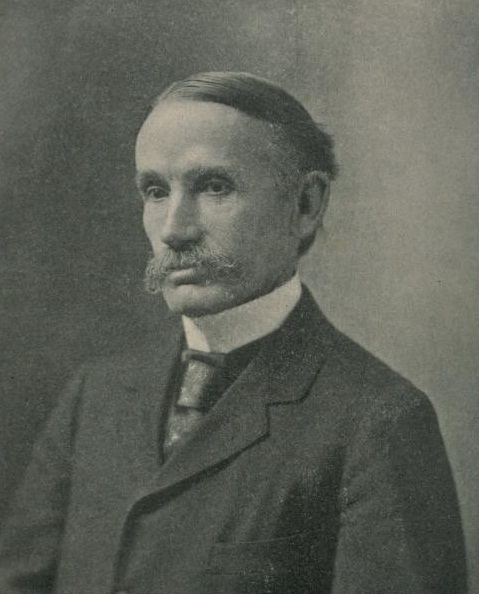Clark’s Early Life and Education
John Bates Clark (1847–1938) was born in Providence, Rhode Island, in the USA. His father, who was a moderately prosperous businessman, traced the family’s roots back to the Puritans.
Clark attended Amherst College in Massachusetts for his higher education. He had originally intended to prepare himself for the ministry, but he decided to switch his major to economics.
Clark was obliged to interrupt his studies for several years, on two separate occasions, in order to take charge of the family business when his father fell ill and eventually died. He received his bachelor’s degree from Amherst in 1872, when he was 25 years old.
Clark spent the next three years studying in Europe, mostly at Heidelberg University in Germany and at the University of Zürich in Switzerland. At Heidelberg, he studied with the distinguished economist Karl Knies, one of the leaders of the German “historical school of economics.”
Clark’s Career
After arriving back in the US in 1875, Clark obtained a teaching position at Carleton College in Northfield, Minnesota. However, due to health problems he was unable to hold classes for a couple of years. Once he did begin offering courses, Thorstein Veblen signed up for them. Veblen went on to become Clark’s most-distinguished former student.
In 1881, Clark moved to Smith College in Northampton, Massachusetts, where he taught until 1893. During this period, he also taught part-time at his old alma mater in nearby Amherst.
From 1893 until 1895, Clark taught full-time at Amherst, while also delivering occasional lectures at Johns Hopkins University in Baltimore, Maryland.
In 1895, Clark joined the recently founded department of political science at Columbia University in New York City, where he remained until his retirement in 1923.
In 1947, the American Economic Association (AEA) instituted the “John Bates Clark Medal,” which is awarded to the American economist under the age of 40 who has made “the most significant contribution to economic thought and knowledge.”
The medal was awarded on a biennial basis from its inception through 2009, but has been awarded annually since then.
The first medal went to Paul Samuelson in 1947, the most-recent one to Isaiah Andrews in 2021.
In terms of prestige, the John Bates Clark Medal is considered to be second only to the Nobel Memorial Prize in Economic Sciences.
Clark’s Ideas
Along with Richard T. Ely, Clark was one of the first important American-born academic economists.
Clark’s most influential contribution to the discipline was probably his extension of the theory of marginal utility and for this reason he is often considered to be one of the pioneers of the “marginalist revolution” in economics.
During the late 1870s and early 1880s, Clark published a series of articles, which he subsequently edited and published together as The Philosophy of Wealth (see “Selected Books Authored or Co-authored by Clark” below) in 1886.
In this, his first and most-famous book, Clark basically added a number of new ideas to the basic theory of marginal utility, building upon previous work by Carl Menger, William Stanley Jevons, and Léon Walras.
Otherwise, Clark is known as a sympathetic critic of free-market economics. Although his former student Veblen caricatured him in print as an apologist for unfettered capitalism, in truth Clark began his life as a socialist in the German historicist model and only gradually came to his later position.
In fact, Clark’s support for the capitalist system was never unqualified. He is best understood, rather, as a representative of the Christian social ethics movement.
Although by the end of his career Clark was writing in defense of competition, he did so in the context of “social justice,” which in his work primarily meant leveling the playing field between capital and labor by encouraging the formation of labor unions.
Selected Books Authored or Co-authored by Clark
The Philosophy of Wealth: Economic Principles Newly Formulated (1886).
Capital and Its Earnings (1888).
The Modern Distributive Process. Studies of Competition and Its Limits, of the Nature and Amount of Profits, and of the Determination of Wages, in the Industrial Society of To-Day, with Franklin H. Giddings (1888).
The Distribution of Wealth: A Theory of Wages, Interest and Profits (1899).
The Control of Trusts: An Argument in Favor of Curbing the Power of Monopoly by a Natural Method (1901).
The Problem of Monopoly: A Study of a Grave Danger and of the Natural Mode of Averting It (1904).
Essentials of Economic Theory, As Applied to Modern Problems of Industry and Public Policy (1907).
Social Justice without Socialism (1914).
Selected Works About Clark
Davanzati, Guglielmo Forges, Ethical Codes and Income Distribution: A Study of John Bates Clark and Thorstein Veblen (2006).
Everett, John Rutherford, Religion in Economics: A Study of John Bates Clark, Richard T. Ely, Simon N. Patten (1946).
Henry, John F., John Bates Clark: The Making of a Neoclassical Economist (1995).
Hollander, Jacob H., ed., Economic Essays: Contributed In Honor of John Bates Clark (1927).
Homan, Paul T., Contemporary Economic Thought (1928).
Leonard, Thomas C., “’A Certain Rude Honesty’: John Bates Clark as a Pioneering Neoclassical Economist,” History of Political Economy, 35: 521–558 (2003).
Marchionatti, Roberto, Economic Theory in the Twentieth Century, An Intellectual History—Volume I: 1890–1918. Economics in the Golden Age of Capitalism (2020).
Morgan, Mary S., “Marketplace Morals and the American Economists: The Case of John Bates Clark,” in Neil De Marchi and Mary S. Morgan, eds., Higgling: Transactors and Their Markets in the History of Economics (= History of Political Economy, Annual Supplement, Volume 26). Durham, NC: Duke University Press; pp. 229–52 (1994).
Persky, Joseph, “The Neoclassical Advent: American Economics at the Dawn of the 20th Century,” Journal of Economic Perspectives, 14: 95–108 (2000).
Stabile, Donald, “The Intellectual Antecedents of Thorstein Veblen: A Case for John Bates Clark,” Journal of Economic Issues, 31: 817–825 (1997).
